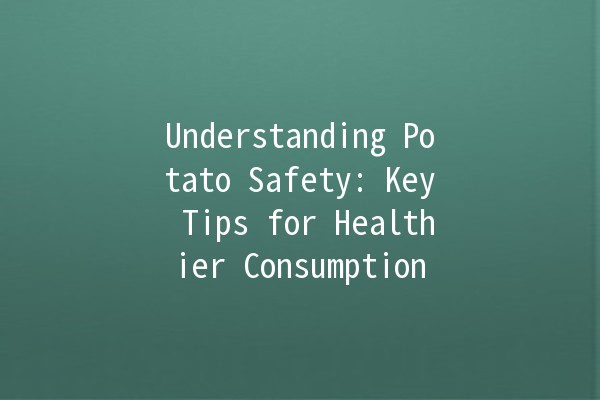Potatoes, a staple food for millions, can be a wonderful part of a balanced diet. However, to enjoy this versatile vegetable safely, it’s crucial to be aware of certain safety measures and best practices. In this article, we will delve deep into the safe consumption of potatoes, providing practical tips and techniques to ensure a healthy and enjoyable eating experience.
The Importance of Potato Safety
Potatoes are rich in nutrients, offering vitamins, minerals, and fiber. However, improper handling or storage can lead to issues that compromise safety. Understanding the potential risks associated with potatoes is vital, including the presence of toxins like solanine. By educating ourselves on potato safety, we can prevent foodborne illness and enjoy potatoes without worry.
Tips for Enhancing Potato Safety
Inspecting potatoes before consumption is essential. Look for signs of spoilage such as:
Sprouting: Potatoes may sprout when stored improperly or for too long. While small sprouts can be removed, extensive sprouting may indicate a decline in quality.
Green Skin: Exposure to light can cause potatoes to turn green, indicating the presence of solanine, a natural toxin. It's best to discard any green potatoes or cut away the green parts if they are minimal.

Softness or Wrinkles: If a potato feels soft or has wrinkled skin, it may be past its prime and potentially unsafe to eat.
Application Example: Always check your potatoes when purchasing them and store them in a cool, dark place to inhibit sprouting and greening.
Storing potatoes correctly is crucial for maximized freshness and safety. Follow these storage techniques:
Cool Temperature: Store potatoes in a cool, dry place, ideally around 4550°F (710°C) to slow down sprouting and preserve freshness.
Avoid Refrigeration: Keeping potatoes in the refrigerator can convert their starches into sugars, affecting flavor and texture while potentially increasing the risk of greening.
Ventilation: Use a breathable bag or basket to maintain air circulation. Avoid plastic bags that trap moisture and promote mold growth.
Application Example: Create a dedicated storage area in your pantry or kitchen to keep potatoes in a cool, dark, and wellventilated environment.
Cleaning potatoes is essential, as soil and bacteria can cling to their skins. Always follow these steps:
Rinse Under Running Water: Before cooking, rinse potatoes under cold running water. This will help remove dirt, bacteria, and pesticides.
Scrub with a Brush: Use a vegetable brush to scrub the surface of the potatoes, especially if you plan to leave the skin on for cooking.
Application Example: Incorporate washing potatoes into your meal prep routine. Allocate time to clean your produce right after grocery shopping to ensure cleanliness.
Cooking potatoes not only enhances their flavor but also contributes to food safety. Proper cooking techniques include:
Boiling: Boil potatoes until they are forktender. This method ensures any bacteria present are killed.
Baking: When baking, ensure potatoes reach an internal temperature of at least 210°F (99°C) to achieve optimum safety.
Avoid Undercooking: Ensure that potatoes are not only cooked through but also tender throughout. Undercooked potatoes can harbor harmful microorganisms.
Application Example: Use a food thermometer to check the temperature of baked potatoes; this ensures they have reached a safe cooking temperature.
Different potato varieties may have unique storage and cooking needs. Some common types include:
Russet Potatoes: Best for baking and frying, they have a high starch content and should be stored in a cool, dark place.
Yukon Gold Potatoes: These versatile potatoes are great for mashing and can be stored similarly to Russets.
New Potatoes: Often harvested early, they have a delicate skin and must be handled with care to avoid bruising.
Application Example: Educate yourself about the potato varieties you purchase and adapt your handling and cooking methods accordingly.
FAQs About Potato Safety
While small sprouts can be removed, potatoes that have extensively sprouted should be discarded. The sprouts can contain solanine, which can be harmful in large amounts. Always check for excessive sprouting and assess the potato's overall condition before consumption.
Green potatoes indicate the presence of solanine, a natural toxin that can cause nausea and headaches. If only a small area is green, you can cut it away and consume the rest. However, if a potato is extensively green, it’s best to discard it entirely.
To responsibly dispose of spoiled potatoes, place them in a compost bin if they're only slightly spoiled. However, if they show signs of rot or mold, it’s better to throw them away in the trash to prevent attracting pests.
Stored properly in a cool and dark place, potatoes can last several weeks to months. However, it's essential to check for signs of spoilage regularly to ensure they remain safe to eat.
Peeling potatoes is not necessary for safety, but it can affect taste and texture. Leaving the skin on can provide added nutrients and fiber. Always wash them thoroughly if you decide to keep the skin on.
Organic potatoes may reduce exposure to pesticides. However, proper washing and cooking techniques are vital for both organic and conventional potatoes to ensure safety. Always wash thoroughly, regardless of potato type.
With careful consideration of these tips and practices, you can enjoy potatoes safely and reap their health benefits. Remember always to prioritize potato safety, from selection to storage, preparation, and cooking. Happy eating!